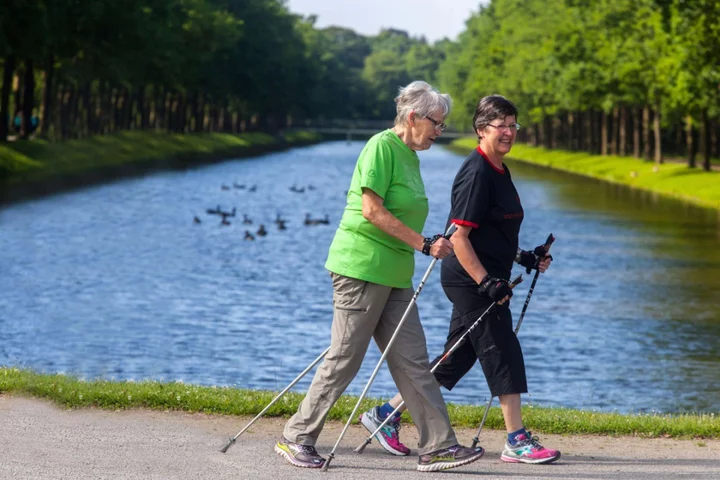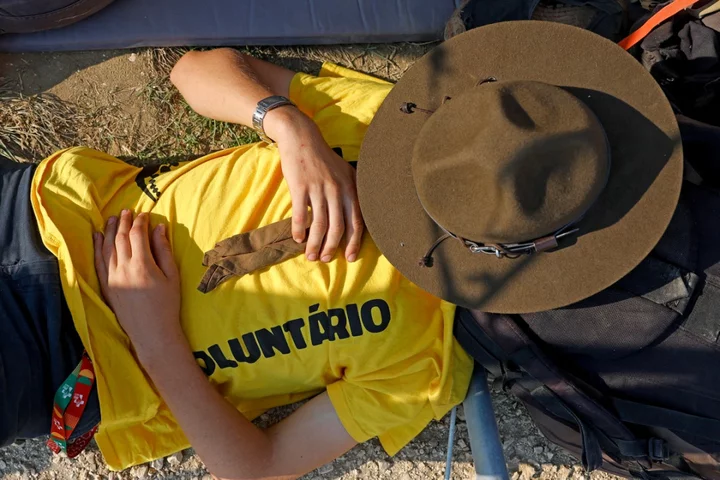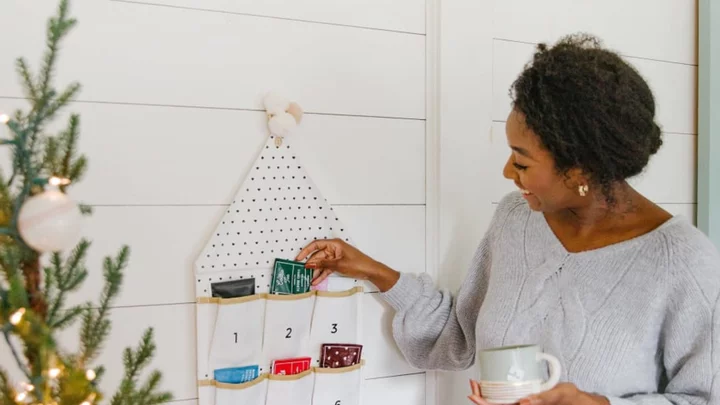
Deadpool 3 delayed from May 2024
'Deadpool 3' is halfway done and unlikely to make its pencilled-in release date next May.
2023-10-20 15:21

‘Do I really look that ridiculous?’ Whoopi Goldberg admits feelings were hurt over reaction to 1993 Oscars look
Whoopi Goldberg has hit back at previous criticism of her infamous outfit choice at the 1993 Oscars. During an interview with Page Six Style at the Fashion Group International Night of Stars gala, Goldberg spoke candidly about her look at the Academy Awards ceremony: A purple and green bejeweled jumpsuit paired with a puffy, long purple jacket with a bright green interior. She completed the outfit with green earrings and heels, and dark purple lipstick. Goldberg went on to recall that when she was hit with backlash for the bold look, she was stung by the criticism. “Everyone hated [it],” she said. “It hurt my feelings, I’m not going to lie. It hurt my feelings.” The View host also confessed that the response to the outfit would go on to affect the way she dressed. “It kept me from dressing up for a very long time,” she said. “You have to remember, in those days, they would say things and you’d think, ‘Do I really look that ridiculous?’” However, she still opened up about the inspiration behind the outfit, specifying that it came from the iconic I Love Lucy sitcom and its lead, the late Lucille Ball. “Lucy would always come out in these great ensembles,” Goldberg said. “And I thought, I would like to wear that! And green is not a color I would normally wear; let me try it.” When asked if she still stands by her decision to wear the bold look at the 1993 Oscars, she simply said: “Absolutely.” Over the years, Goldberg has gone on to embrace her own sense of style, launching her own clothing line, Dubgee, in 2019. Speaking to InStyle about the brand – which sells a range of stretchy jeans and hoodies – she shared her candid thoughts about fashion, expressing that people shouldn’t let their age determine what types of clothes they wear. “People will always say to somebody young, ‘Oh, you’re dressing so old,’ and they will say to an older woman, ‘Oh, you’re dressing too young,’” she told the publication in 2019. “The clothes that we made, you could be 21 and wear it, you could be 65 and wear it, you could be whatever age you are and look good in it. And feel good in it. You’re not too old to wear anything that makes you happy. That’s the key. The only important voice, ever, is your own.” In July of this year, the Sister Act star also made headlines for her shoe choice on The View: A pair of clear platforms with decapitated heads of Barbie dolls in them. Although she wore the heels to celebrate the highly-anticipated premiere of Barbie, she told Page Six Style that she’s actually had these “crazy” shoes for quite some time. “Someone sent them to me and I thought, what are these?! It was about three years before Barbie. I did Barbiecore first!” she said, referring to the fashion trend where people have been showing off their looks inspired by the Mattel doll. Read More Victoria’s Secret ditches feminist makeover after sales slump Black magic: Go back to black this season with the catwalk-inspired trend From collars to gloomy garments: How to dress like Wednesday Addams for Halloween
2023-10-20 15:17

Jon Bon Jovi named MusiCares Person of the Year
Jon Bon Jovi has been named the 2024 MusiCares Person of the Year and will be honoured at a special gala in February.
2023-10-20 15:15

World Osteoporosis Day: The risk factors and early warning signs everyone needs to know about
October 20 marks World Osteoporosis Day – but despite being a relatively common condition, many people are unaware they’re at risk. According to Age UK, osteoporosis – which is associated with weakened bones and often referred to as a ‘silent disease’, as symptoms can creep up on people – affects approximately three million people in the UK. Yet, many only find out they have it when they break a bone. “[Osteoporosis] is a condition characterised by weakened bones, making them more prone to fractures,” explains Dr Zulqarnain Shah, a medical director at SSP Health. “It occurs when the body loses too much bone or makes too little bone, or both. Diagnosis of osteoporosis typically involves a combination of medical history, physical examination, and specialised tests, such as bone mineral density scans,” Shah adds. Could I be at risk of osteoporosis? According to Age UK, around half of women over 50, and around one in nine men in the same age group, will experience a fracture due to osteoporosis. However, several risk factors contribute to the development of the condition, meaning some people may be more likely to get it. “These include menopause, low calcium and vitamin D intake during younger years, family history, a sedentary lifestyle, smoking, excessive alcohol consumption, and certain medications,” explains Shah. “While it may not be possible to prevent all cases of osteoporosis, adopting a healthy lifestyle with regular weight-bearing exercise, a balanced diet rich in calcium and vitamin D, and avoiding smoking and excessive alcohol intake can help reduce the risk.” Being aware of osteoporosis can be particularly important if you have a family history. “A family history of osteoporosis or fragility fractures can indicate an increased risk,” explains Dr Elise Dallas, GP at The London General Practice. Other things that increase risk include having a history of “rheumatoid arthritis, low levels of oestrogen due to early menopause, anorexia nervosa or Turner’s syndrome, hyperthyroidism, parathyroid disease, Crohn’s and coeliac disease, and conditions that cause long periods of immobility”, adds Dallas. What are the symptoms of osteoporosis? When you have osteoporosis, you may suffer from “increased fracture risk, height loss, and chronic pain”, says Shah. “Fractures associated with osteoporosis are known as ‘fragility fractures’, which can occur with minimal impact. Fractures commonly occur in the spine, hip, and wrist, and can lead to significant pain, disability, and reduced quality of life,” he explains. Are there any early warning signs? Shah says: “Early signs of osteoporosis may not be apparent until a fracture occurs. However, a precursor condition called osteopenia may be detected through scans before the onset of full-blown osteoporosis.” Osteopenia is where the density of the bones decreases, but not thoroughly enough to be classed as osteoporosis. There are no real symptoms however, so it can only be detected with scans. The good news is, lifestyle measures and sometimes treatment can help prevent it getting worse. How is osteoporosis treated? Treatment for osteoporosis is mostly aimed at “strengthening bones and preventing fractures”, says Shah. “This typically involves a combination of lifestyle modifications, such as exercise and dietary changes, along with medication. “Medications may include calcium, vitamin D and bisphosphonates, hormone therapy for postmenopausal women, selective oestrogen receptor modulators (SERMs), and other options. “SERMS help manage the way oestrogen interacts with your body and has a similar impact on osteoporosis as hormone replacement therapy, to help mitigate the impacts of hormones on osteoporosis,” Shah explains. “Regular monitoring and adherence to treatment plans can help slow down or stop the progression of osteoporosis. A bone density scan – also known as a DEXA scan – can help monitor the progress of a condition and may be done at three to five-year intervals to assess progress. “Once a patient has been on bisphosphonates for five years, they may go on a ‘pill holiday’ for a couple of years, though the benefits of taking bisphosphonates continue long after the medication is stopped.” Getting support and advice to manage any pain and mobility challenges and reduce the risk of falls and injuries can also be very important for people living with osteoporosis, along with finding ways to stay active. If you are worried about your bones and osteoporosis risk you can reach out to charities like the Royal Osteoporosis Society and find out about your risk level. Read More How to support a child with a stammer From colourful gowns to drones, these wedding trends are set take over 2024 Call The Midwife ‘should come with a health warning’ Halloween: 10 wicked ways to kit out your haunted house Black magic: Go back to black this season with the catwalk-inspired trend How to prep your home for when the clocks go back
2023-10-20 14:46

How to support a child with a stammer
For people with a stammer, it can be hard to deal with, but it’s made worse by the fact that understanding of the condition amongst the general public is low. The speech problem usually starts in childhood, between the ages of around two and five years old, affecting around 8% of children and 2% of adults – that’s more than 1.3 million people in the UK. International Stammering Awareness Day (October 22) aims to destigmatise stammering and promote understanding and support for people who do have it, including advice for parents about how they can help affected children. “There’s a lot of stigma around stammering in society – even from an early age, children may be teased or bullied, and adults may tell them to speak properly,” says Catherine Woolley, children and families programme lead at STAMMA (the British Stammering Association). “Children who stammer sometimes feel embarrassed or worried about their speech and try to hide it. They might start to speak less or change words they want to say to ones which are easier to produce. “How you respond to your child can affect how they feel about their talking. It’s common for parents to worry about stammering, and if this is you, you can seek support to help you feel comfortable around your child’s stammering.” Woolley points out that, contrary to popular belief, stammering isn’t caused by anxiety or stress, and there’s no evidence that people who stammer are less intelligent than fluent speakers. “Research suggests stammering is neurological, which means there are subtle differences in the way the brains of people who stammer work,” she explains. “This means it belongs to the same group of neurodiverse conditions as ADHD, autism and dyslexia.” The condition is often hereditary, with about 60% of people who stammer having another family member who stammers, and while there’s no specific cure, Woolley says there are many different techniques and approaches that can increase people’s fluency in certain situations, although they may not work for everyone. “There isn’t one treatment which can miraculously make all people stop stammering,” she stresses. “Everyone’s stammer is unique, as is the way they want to manage their speech.” But there’s no doubt, she says, that parents can help their children deal with stammering, and make them feel more comfortable. 1. Value your child’s stammered voice “It’s simply the way they talk,” says Woolley. “What’s important is what they say and not the way they say it.” 2. Be patient Although it can obviously take more time for a child who stammers to say something, it’s important for parents and the rest of the family not to rush them. “Give them time to say what they want, and model this to their siblings and other family members,” she adds. 3. Don’t finish their words or sentences Woolley says that while it can be tempting to finish your child’s words or sentences for them, especially if you can see them struggling, it’s important to resist this urge to help. “It can be disempowering and embarrassing if you speak over them,” explains Woolley, “not to mention frustrating if your guess is wrong and they have to start all over again.” 4, Slow down yourself Rather than telling your child to speed up, slow down your own speech to reduce any time pressure they may feel. 5. Don’t show your own anxietyEven if you feel anxious when your child is stammering, try not to show it, advises Woolley, who suggests maintaining natural eye contact and remaining calm. “It can be uncomfortable listening to someone who stammers, but think how they feel. Try and maintain eye contact even if you feel awkward, as looking away can make them feel awkward too, or think you’ve lost interest in what they’re saying. Keep looking at them and give the occasional encouraging head nod to show you’re interested.” 6. Try not to be negative Woolley says it can be important to describe stammering using neutral language instead of negative references. So, for example, say, ‘He’s stammered more this week’, rather than, ‘His speech has been bad’. 7. Seek help Parents who are worried about their child’s talking or would like some help should contact their local NHS speech and language therapy department to talk through their concerns. In addition, STAMMA offers free Parent2Parent peer support groups run by parents of children who stammer, and workshops for such parents, plus a helpline (0808 802 0002) and a webchat service. Read More From colourful gowns to drones, these wedding trends are set take over 2024 Call The Midwife ‘should come with a health warning’ Halloween: 10 wicked ways to kit out your haunted house Black magic: Go back to black this season with the catwalk-inspired trend How to prep your home for when the clocks go back Menopause campaigner Mariella Frostrup: ‘I look forward to a future where women gradually stop feeling so ashamed’
2023-10-20 14:25

Hitting snooze button can actually benefit brain sometimes, study suggests
Hitting the snooze button on the alarm clock once in a while might actually support the brain’s process of waking from deep sleep, according to a new study. People sometimes want to go right back to sleep even after the alarm goes off in the morning, using the snooze button in clocks and cell phones. Decades of previous research suggested that hitting snooze can have negative effects, both on sleep and the brain’s ability to wake up, but until now there hasn’t been any direct evidence of this, say scientists. The new study, published in the Journal of Sleep Research, assessed how common snoozing is and what effects this behaviour has on sleep, sleepiness, mood, and the brain’s cognitive abilities. Researchers found that those who snooze on an average sleep slightly shorter and feel more drowsy in the morning compared to those who never snooze. But they also saw that there were no negative effects of snoozing on the release of the stress hormone cortisol, mood, or sleep quality throughout the night. In the study, 1732 individuals answered questions about their morning habits, including how often they hit the snooze button with many – especially young adults – reporting that they use the alarm feature regularly. The most common reason for snoozing, according to participants, is feeling too tired to get out of bed when the alarm goes off. In another small follow-up experiment, 31 regular snoozers spent two nights in a sleep lab in order to measure their sleep in more detail. On one of the mornings, they were allowed to snooze for 30 minutes, and on the other, they had to get up right when the alarm went off. While in the first case, participants’ sleep was disturbed during the half hour of snoozing, most of them still got more than 20 minutes of sleep – meaning that their total night’s sleep was not affected much. In the snooze condition, no one had to wake up suddenly from deep sleep, and the snoozers performed a bit better on cognitive tests right upon waking. There were also no clear effects of snoozing on mood, sleepiness, or the amount of cortisol in the saliva. The results hint that half an hour of snoozing may not have negative effects on night sleep and could have some positive effects like a decreased likelihood of waking from deep sleep. However, researchers caution that the second experiment was small and only included people who are regular snoozers who find it easy to go back to sleep after each alarm. They say snoozing is most likely not for everyone. Jennifer Kanaan from the University of Connecticut in the US, who is another sleep scientist unrelated to the study, said the latest findings should be interpreted with caution as it could send the wrong message to people. “If you’re coming in and out of sleep for 30 minutes, after the alarm goes off the first time, you’re costing yourself 30 minutes of uninterrupted, quality, restorative sleep,” Dr Kanaan said in a statement. Instead of trying to figure out how to manipulate our alarm clocks, she says people should make a consistent good night’s sleep a greater priority and be less reliant on snooze buttons. “Simply put, instead of hitting the snooze button they should get more sleep,” Dr Kanaan said. Read More Study reveals why millions of women wake up at 3.29am Consistent lack of sleep may increase risk of future depressive symptoms – study Breakthrough study allows scientists to communicate with people as they sleep How to support a child with a stammer ‘I lost nearly a stone on Ozempic, but now it’s run out what am I to do?’ Miriam Margolyes now has part of a cow’s heart as she opens up about health
2023-10-20 14:20

Factbox-Corporate America weighs risks of the Ozempic effect
U.S. companies across sectors such as food and beverage makers and manufacturers of glucose monitors have faced investor
2023-10-20 10:58

Merck signs $5.5 billion deal with Daiichi for cancer therapy development
TOKYO (Reuters) -Japan's Daiichi Sankyo announced on Friday a $5.5 billion agreement with Merck to jointly develop its three precision
2023-10-20 09:23

Sorry, Barbie! Actors Guild Releases Guidelines for Striking Members’ Halloween Costumes
The SAG-AFTRA actors’ strike has rules about how to celebrate Halloween this year.
2023-10-20 04:55

This Advent Calendar Is Perfect for Tea Lovers
Count down to Christmas the best way possible: by brewing delicious tea.
2023-10-20 03:27

Whoopi Goldberg says her feelings were hurt over reaction to infamous Oscars dress
Whoopi Goldberg has hit back at previous criticism of her infamous outfit choice during the ‘90s. During an interview with Page Six Style at the Fashion Group International Night of Stars gala, Goldberg spoke candidly about her look at the 1993 Oscars: A purple and green bejeweled jumpsuit paired with a puffy, long purple jacket with a bright green interior. She completed the outfit with green earrings and heels, and dark purple lipstick. Goldberg went on to recall that when she was hit with backlash for the bold look, she was stung by the criticism. “Everyone hated [it],” she said. “It hurt my feelings, I’m not going to lie. It hurt my feelings.” The View host also confessed that the response to the outfit would go on to affect the way she dressed. “It kept me from dressing up for a very long time,” she said. “You have to remember, in those days, they would say things and you’d think, ‘Do I really look that ridiculous?’” However, she still opened up about the inspiration behind the outfit, specifying that it came from the iconic I Love Lucy sitcom and its lead, the late Lucille Ball. “Lucy would always come out in these great ensembles,” Goldberg said. “And I thought, I would like to wear that! And green is not a color I would normally wear; let me try it.” When asked if she still stands by her decision to wear the bold look at the 1993 Oscars, she simply said: “Absolutely.” Over the years, Goldberg has gone on to embrace her own sense of style, launching her own clothing line, Dubgee, in 2019. Speaking to InStyle about the brand – which sells a range of stretchy jeans and hoodies – she shared her candid thoughts about fashion, expressing that people shouldn’t let their age determine what types of clothes they wear. “People will always say to somebody young, ‘Oh, you’re dressing so old,’ and they will say to an older woman, ‘Oh, you’re dressing too young,’” she told the publication in 2019. “The clothes that we made, you could be 21 and wear it, you could be 65 and wear it, you could be whatever age you are and look good in it. And feel good in it. You’re not too old to wear anything that makes you happy. That’s the key. The only important voice, ever, is your own.” In July of this year, the Sister Act star also made headlines for her shoe choice on The View: A pair of clear platforms with decapitated heads of Barbie dolls in them. Although she wore the heels to celebrate the highly-anticipated premiere of Barbie, she told Page Six Style that she’s actually had these “crazy” shoes for quite some time. “Someone sent them to me and I thought, what are these?! It was about three years before Barbie. I did Barbiecore first!” she said, referring to the fashion trend where people have been showing off their looks inspired by the Mattel doll. Read More Whoopi Goldberg calls out Rachel Bilson for comments about men’s sexual partners Victoria’s Secret ditches feminist makeover after sales slump Black magic: Go back to black this season with the catwalk-inspired trend
2023-10-20 03:19

Optimus Prime vs. My Little Pony: The Toy Hall of Fame Wants You To Vote On Its Next Inductee
Rainbow Dash is up against the Decepticons this year in a vicious battle for toy supremacy.
2023-10-19 23:19
